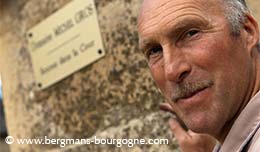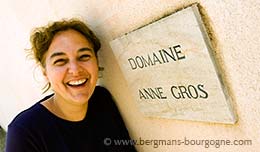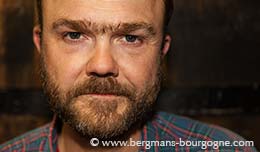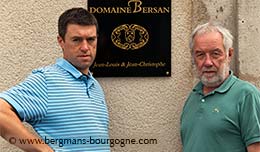
aranges at the southern tip of the Côte de Beaune holds seven premier crus, all located on the Santenay side of the appellation. You’ll find three of them in the Domaine Jeannot cellars – Clos Roussots, La Fussière and Clos des Loyères.
– All three are vinified in the same way, says Quentin Jeannot. Everything is de-stemmed. I use between 30 and 40 per cent new oak. The barrels come from two different coopers.
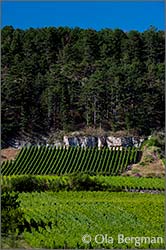 The three premier crus are close to each other. The difference lies in the soil.
The three premier crus are close to each other. The difference lies in the soil.
– Clos Roussots is marl, clay and limestone, says Quentin Jeannot. The lower part is flat. Clos des Loyères is at the beginning of the slope with clay and limestone. Fussière on the other hand has a lot of limestone and is also higher up on the slope, with a full southern exposure. This is the same slope as Santenay’s premier cru Clos Rousseau.
The Maranges Clos Roussots of Domaine Jeannot is a peculiarity in that the parcel is not connected to the rest of the clos. The parcel of the domaine is a small triangle squeezed in between Maranges Clos de la Boutière and the Clos Rousseau of Santenay.
 – Our Clos Roussots is a small parcel, says Quentin Jeannot. Annual production is just 500 bottles. That’s all. I don’t why it has become like this, separated from the rest, but it’s a very good parcel. It’s just we there.
– Our Clos Roussots is a small parcel, says Quentin Jeannot. Annual production is just 500 bottles. That’s all. I don’t why it has become like this, separated from the rest, but it’s a very good parcel. It’s just we there.
Domaine Jeannot is a relatively new setup. Back in 1995 it was Quentin Jeannot’s parents who decided it was time for a career change and began buying vineyards. Located in Saint-Sernin-du-Plain, which is roughly half-way between the three Maranges villages and Couches, the main portion of the production is Maranges and Santenay in various forms. The main cellar is still in Saint-Sernin-du-Plain. More recently another cellar was added in Meursault.
 Saint-Sernin-du-Plain is part of the Couchois. Located in between the Côte de Beaune and the Côte de Chalonnaise, the Couchois is a bit of a no-man’s-land in the middle of Burgundy. Apart from the basic regional appellations there is only one appellation which stands out here, the Bourgogne Côte du Couchois, a regional appellation that as well. In total there are just eight hectares under production in the six communes - Couches, Dracy-lès-Couches, Saint-Jean- de-Trézy, Saint-Maurice-lès-Couches, Saint-Pierre-de-Varennes and Saint- Sernin-du-Plain – entitled to use the appellation.
Saint-Sernin-du-Plain is part of the Couchois. Located in between the Côte de Beaune and the Côte de Chalonnaise, the Couchois is a bit of a no-man’s-land in the middle of Burgundy. Apart from the basic regional appellations there is only one appellation which stands out here, the Bourgogne Côte du Couchois, a regional appellation that as well. In total there are just eight hectares under production in the six communes - Couches, Dracy-lès-Couches, Saint-Jean- de-Trézy, Saint-Maurice-lès-Couches, Saint-Pierre-de-Varennes and Saint- Sernin-du-Plain – entitled to use the appellation.
– We used to produce Bourgogne Côte du Couchois, says Quentin Jeannot, but we felt we had too many appellations. We have two hectares of vineyards around here. The rest of the domaine, eight hectares, are mainly around Maranges, Santenay and Meursault. 50 per cent of our production is Maranges and Santenay.
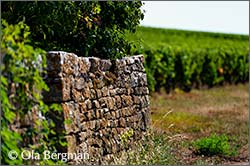 The vineyards around Saint- Sernin-du-Plain were planted by Quentin Jeannot’s grandfather, which makes them between 70 and 80 years old. Yields are low. Between 35 and 40 hectolitres per hectare. The maximum yield for the regional appellations is 55 hl/ha for the red and 60 hl/ha for the white.
The vineyards around Saint- Sernin-du-Plain were planted by Quentin Jeannot’s grandfather, which makes them between 70 and 80 years old. Yields are low. Between 35 and 40 hectolitres per hectare. The maximum yield for the regional appellations is 55 hl/ha for the red and 60 hl/ha for the white.
Quentin Jeannot makes a red Bourgogne Hautes-Côtes de Beaune, a cuvée called Dame Nature. The vines are old here as well. About 80 years.
– It’s the first vineyard my parents bought, he says. It’s in Cheilly-lès-Maranges. Between Cheilly and Château de Mercey. It’s in the plains, south-facing. The yield is 40-45 hl/ha.
The old vines cuvée of red village appellation Maranges is one of the biggest of Domaine Jeannot. Around 20 000 bottles is what they produce every year.
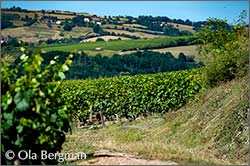 – Maranges is difficult to sell abroad, says Quentin Jeannot. But that’s not the case in France, because it’s the first appellation in the Côte de Beaune and the price/quality ratio is good. It’s slowly catching on abroad, but I never sell any Maranges to Japan. I sell all other appellations there, but no village Maranges or premier cru Maranges. The character of the these wines is a bit more rustic, a bit tougher. That might explain it.
– Maranges is difficult to sell abroad, says Quentin Jeannot. But that’s not the case in France, because it’s the first appellation in the Côte de Beaune and the price/quality ratio is good. It’s slowly catching on abroad, but I never sell any Maranges to Japan. I sell all other appellations there, but no village Maranges or premier cru Maranges. The character of the these wines is a bit more rustic, a bit tougher. That might explain it.
In Santenay Quentin Jeannot has less premier cru – just one – but more village appellation bottlings – three reds and one white – than in Maranges.
– Our Santenay, Clos Des Hâtes is white, he says. The soil in our part is more suitable for white. Olivier Lamy and Vincent Morey make red Clos Des Hâtes.
 – In red there is Les Charmes. Compared with Maranges it is more silky. It’s a lighter wine, not for keeping. It’s all about fruit and finesse. The vines are 80 years old. We have two parcels. One in Les Charmes Dessous and one in Les Charmes Dessus. You have slightly more clay in the upper parcel, but the soil character is very similar.
– In red there is Les Charmes. Compared with Maranges it is more silky. It’s a lighter wine, not for keeping. It’s all about fruit and finesse. The vines are 80 years old. We have two parcels. One in Les Charmes Dessous and one in Les Charmes Dessus. You have slightly more clay in the upper parcel, but the soil character is very similar.
The Maranges side of Santenay generally has more clay, while the Chassagne-Montrachet has more limestone. The majority of the Santenay premier crus are on the Chassagne-Montrachet side, just northeast of the village. The old vines Santenay comes from a vineyard near the casino, where the soil is not very deep. On the other side of the village, at the top of the premier crus, Domaine Jeannot has a parcel in Clos de la Comme Dessus.
– The vines there are at least 50 years old. There is always a lot of millarandage. The yield is low, 30–35 hl/ha. For us the first vintage was in 2017.
– Our only premier cru in Santenay is Passetemps. Next to it is Gravières and then it’s Morgeot in Chassagne-Montrachet. Passetemps has a lot of limestone. It’s a wine with lots of minerality. But there is not much Passetemps available. We are just a handful of owners there. Apart from us you have Domaine Fleurot Larose, Domaine Roger Belland, Domaine Mestre, Domaine Lequin-Colin, Domaine Jean-Marc Vincent, Domaine Louis Lequin and my cousin Benoît (Domaine Yves Girardin).
Domaine Jeannot is a predominantly red domaine. Only ten per cent is white wine. The domaine owns some village appellation Meursault, but the three Meursault premier crus – Charmes, Perrière and Poruzots – are all bought as grapes. This goes for the grand cru, the Corton-Charlemagne, as well.
© 2019 Ola Bergman










